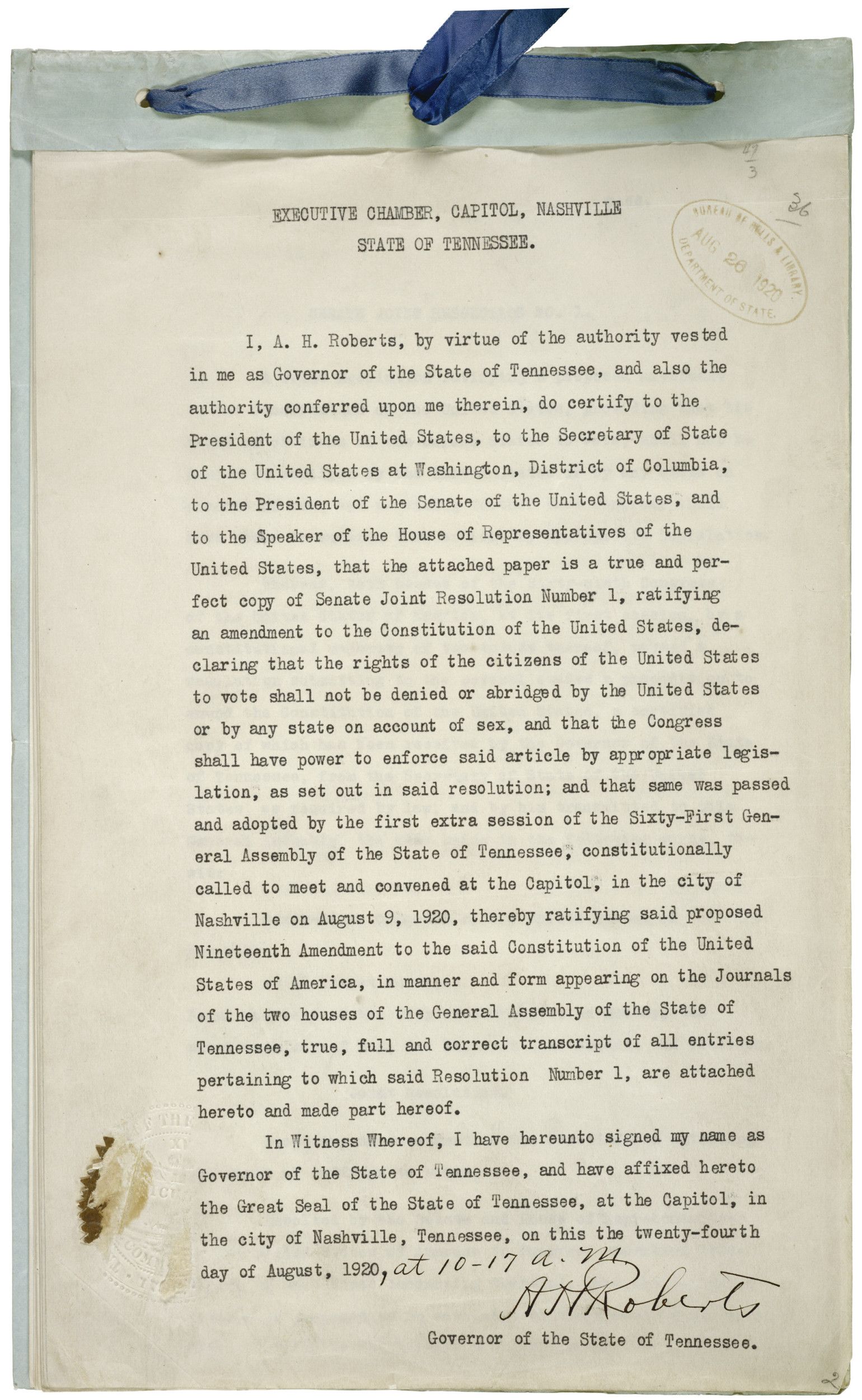Extending Suffrage to Women
Finding a Sequence
All documents and text associated with this activity are printed below, followed by a worksheet for student responses.Introduction
The woman suffrage movement was a long struggle, spanning many major events in American history. In this activity, you will see eleven different documents arguing both for and against the right to vote for women. Put them in the correct chronological order that they were created.As you work, make a list of the arguments that suffragists and anti-suffragists used to convince others of their opinions - you must closely examine each to be able to do this.
Name:
Class:
Class:
Worksheet
Extending Suffrage to Women
Finding a Sequence
Examine the documents in this activity. Put the corresponding document numbers in order using the list below. Write your conclusion response in the space provided.1
2
3
4
5
6
7
8
9
10
11
1
Activity Element
Anti-Suffrage Postcards from Wallace Ellis to the Honorable Homer P. Snyder
Page 1
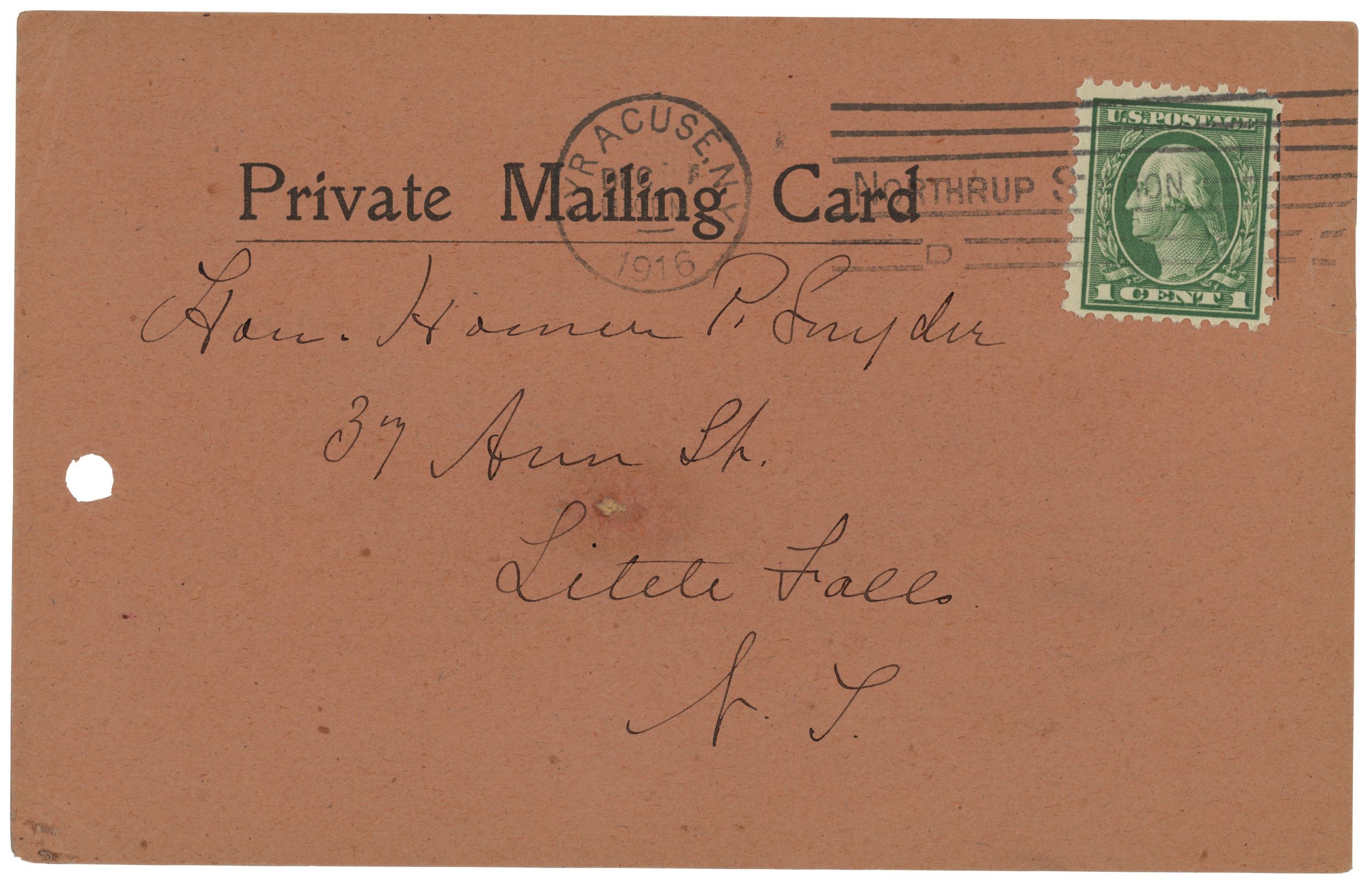
2
Activity Element
Letter to the United States Congress from Elizabeth Cady Stanton and Susan B. Anthony and Others in Support of Women's Suffrage
Page 1

3
Activity Element
Photograph of Suffrage Parade
Page 2

4
Activity Element
Petition from Minnie Fisher Cunningham of the Texas Woman Suffrage Association for passage of the "Susan B. Anthony Amendment"
Page 2
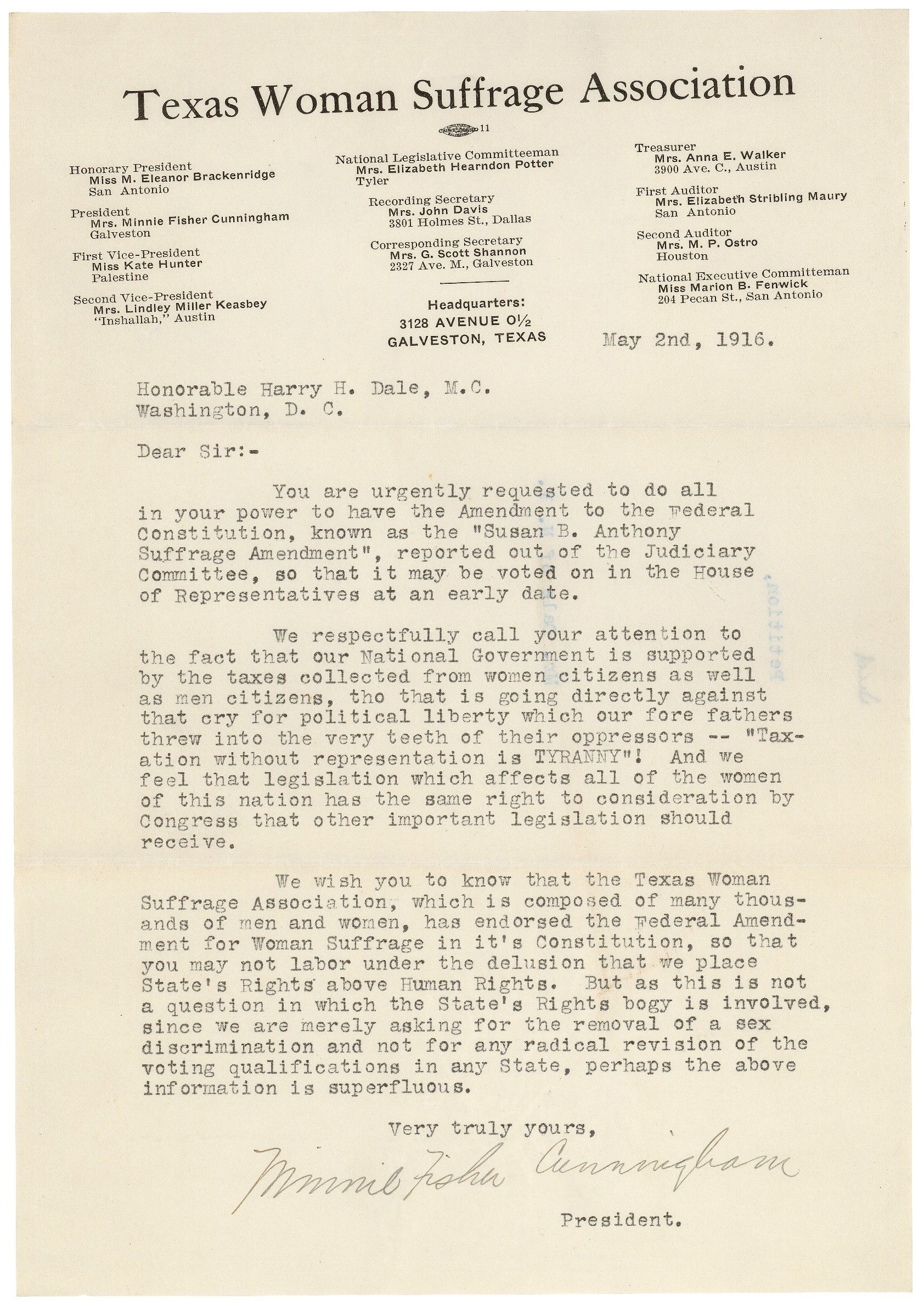
5
Activity Element
Tennessee's Ratification of the 19th Amendment
Page 2
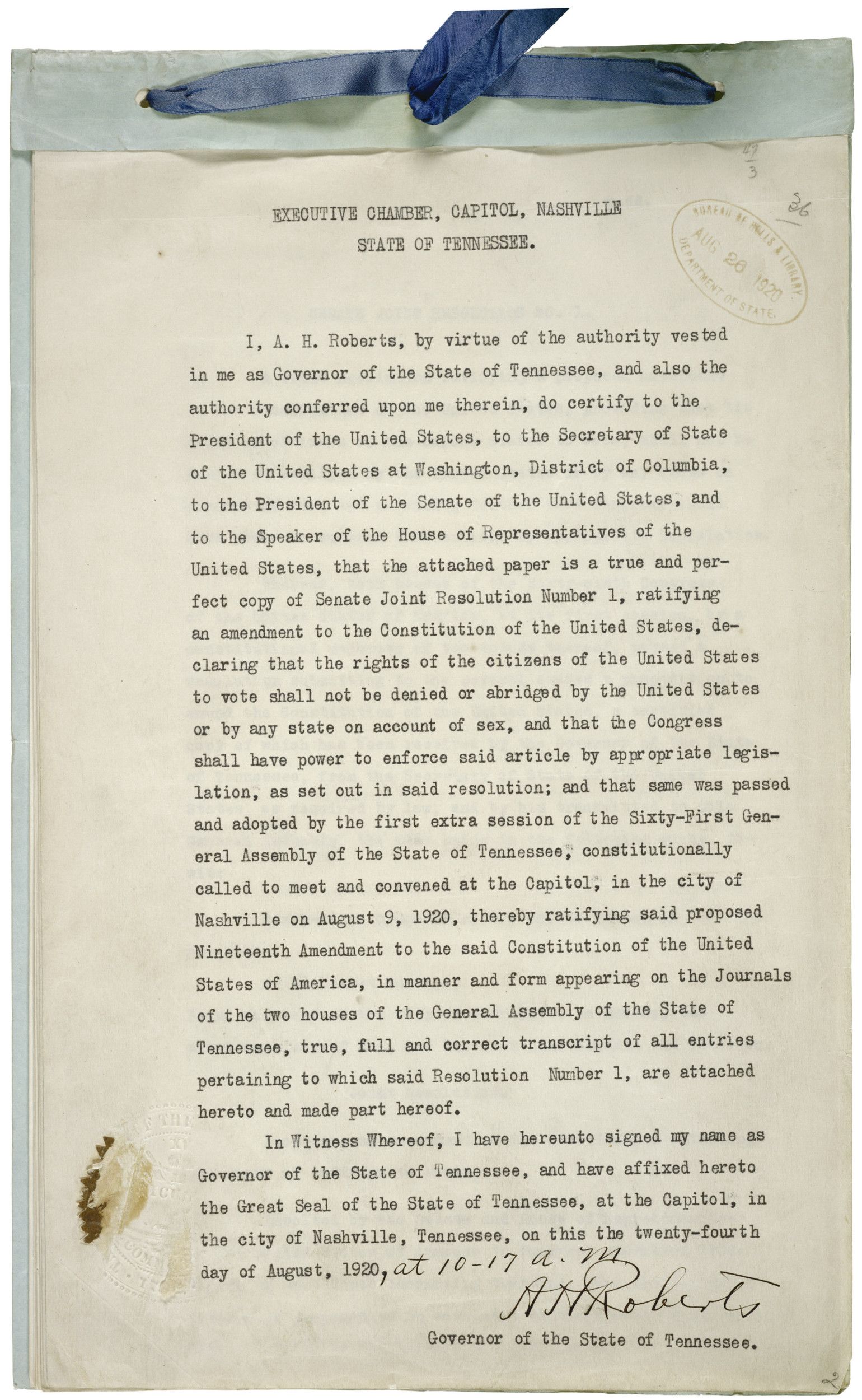
6
Activity Element
U.S. vs. Susan B. Anthony, Record of Conviction
Page 1
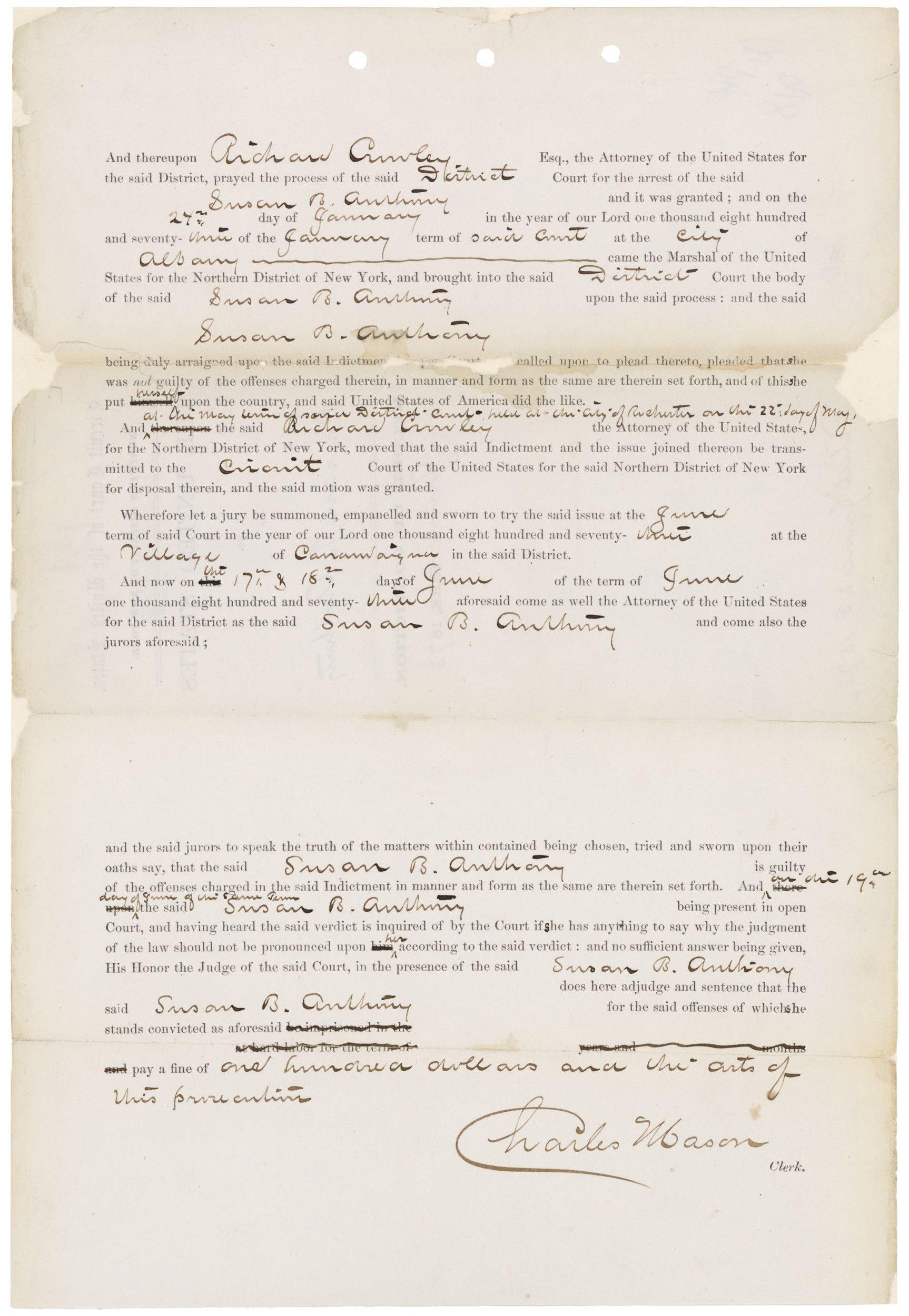
7
Activity Element
Form letter from E. Cady Stanton, Susan B. Anthony, and Lucy Stone asking friends to send petitions for women's suffrage to their representatives in Congress
Page 1
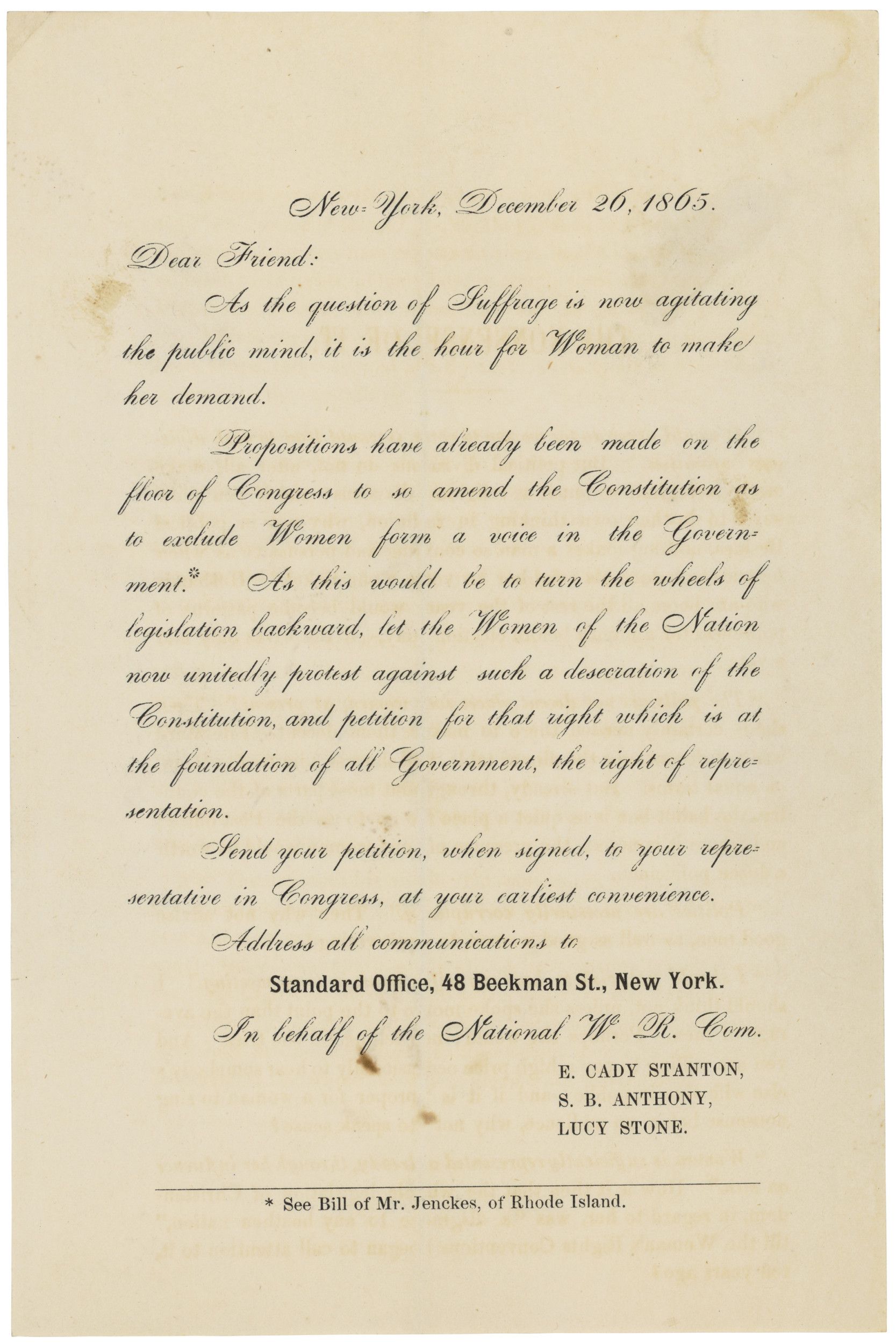
8
Activity Element
Joint Resolution Proposing the Fifteenth Amendment to the United States Constitution
Page 1
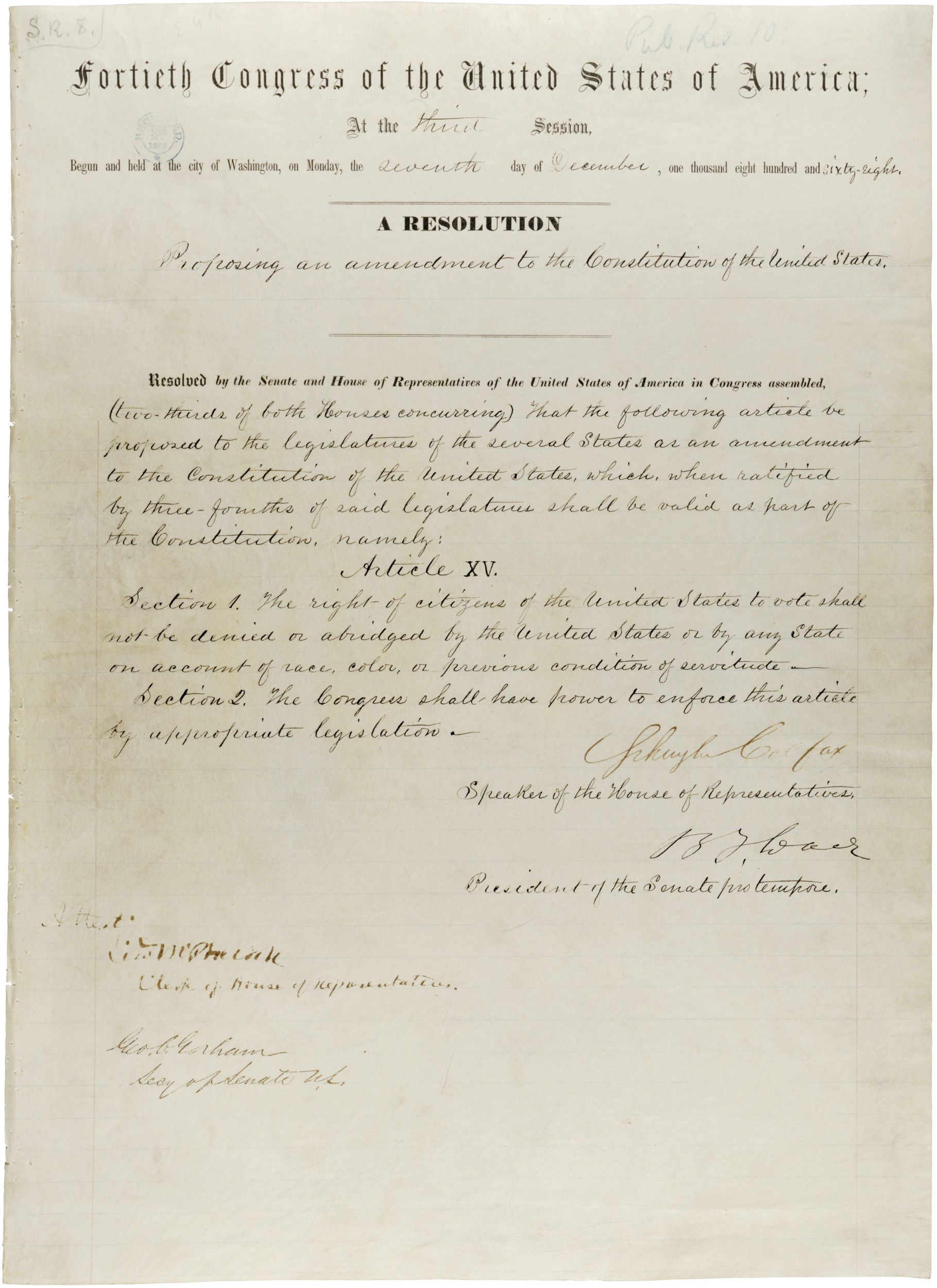
9
Activity Element
Petition from Carrie Chapman Catt of the National American Woman Suffrage Association asking that a Committee on Woman Suffrage be appointed in the House of Representatives as in the Senate
Page 1
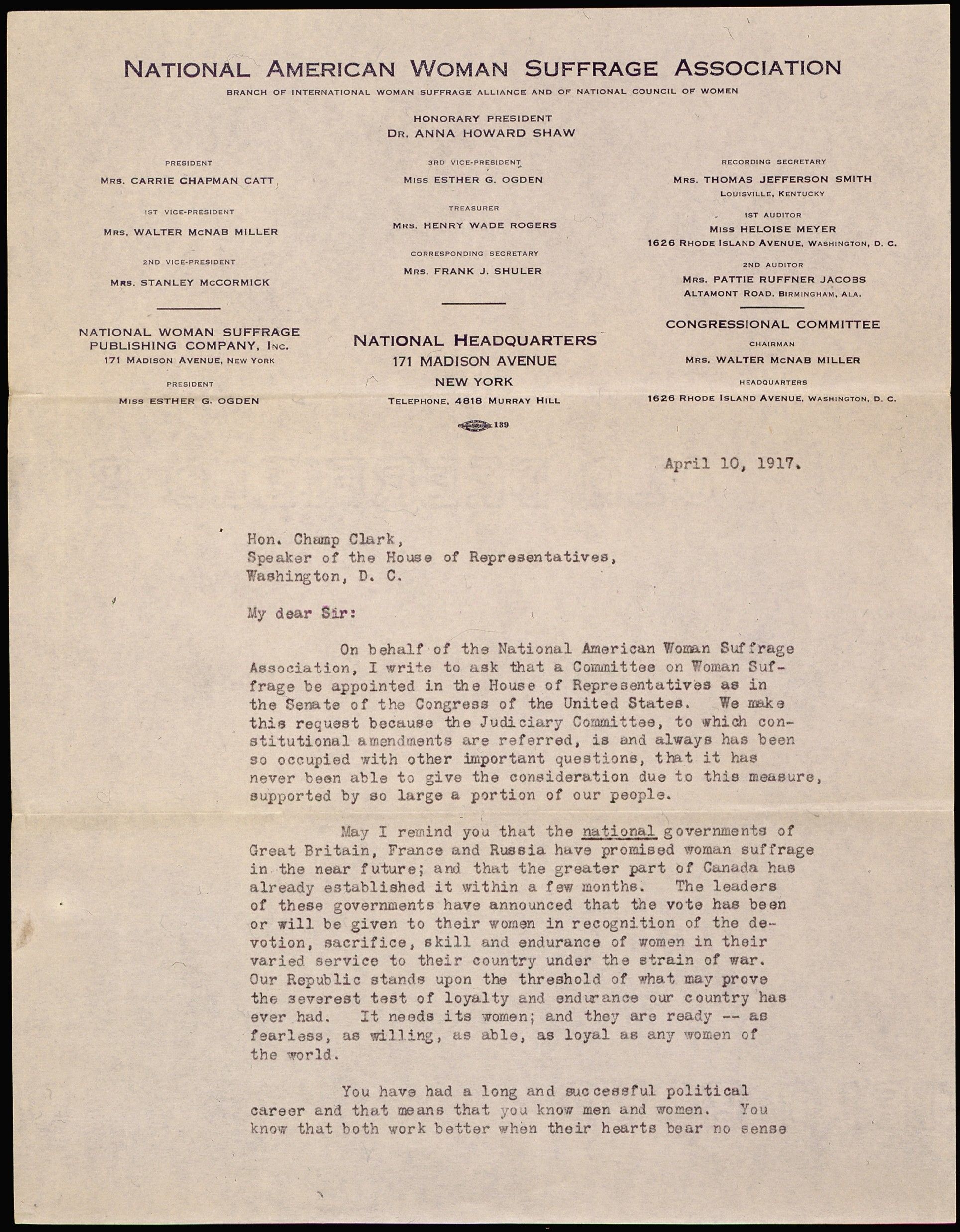
10
Activity Element
Memorial of Alice Wadsworth of the National Association Opposed to Woman Suffrage
Page 1
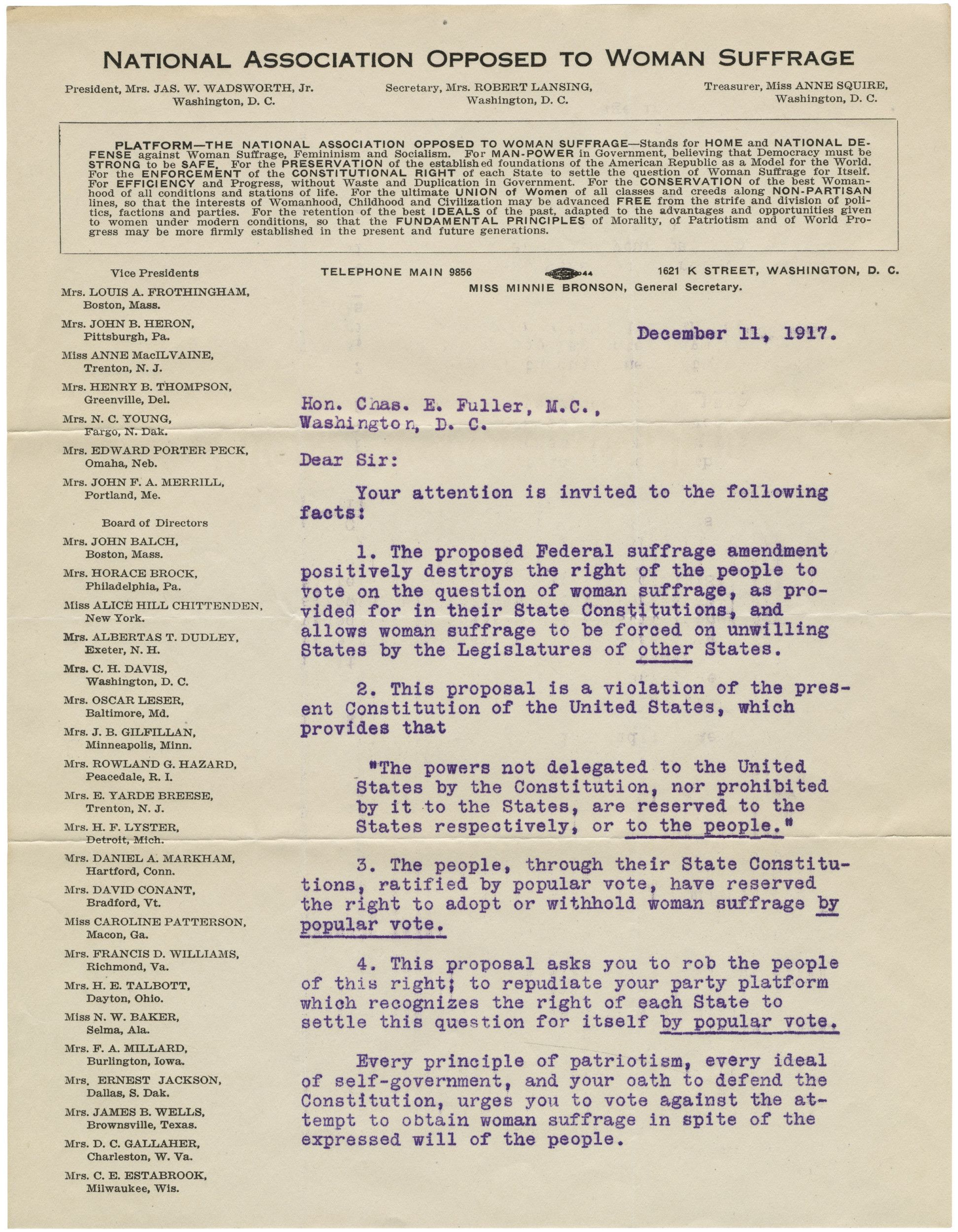
11
Activity Element
"Appeal for a Sixteenth Amendment" from the National Woman Suffrage Association
Page 1

Conclusion
Extending Suffrage to Women
Finding a Sequence
You’ve put these documents together to show the progression of the woman suffrage movement.Make a list: What were the various tools and techniques that women and men used to fight for the right to vote for women?
Your Response
Document
'Appeal for a Sixteenth Amendment' from the National Woman Suffrage Association
11/10/1876
Susan B. Anthony and Elizabeth Cady Stanton signed this appeal, from the National Woman Suffrage Association, to dedicate the nation’s second century to “securing justice to Woman.” It asked women to gather signatures and send them in to make “ the largest petition ever yet.”
This primary source comes from the Records of the U.S. House of Representatives.
National Archives Identifier: 306647
Full Citation: 'Appeal for a Sixteenth Amendment' from the National Woman Suffrage Association; 11/10/1876; Petitions and Memorials, 1813 - 1968; Records of the U.S. House of Representatives, ; National Archives Building, Washington, DC. [Online Version, https://docsteach.org/documents/document/appeal-for-sixteenth-amendment, April 23, 2024]'Appeal for a Sixteenth Amendment' from the National Woman Suffrage Association
Page 1

Document
Memorial of Alice Wadsworth of the National Association Opposed to Woman Suffrage
12/11/1917
Formed in 1911, the National Association Opposed to Woman Suffrage had branches in 25 states by 1916. In this memorial to U.S. House of Representatives member Charles E. Fuller, President Alice H. Wadsworth and the association's women members argue against voting, citing the rights of individual states, the threat of feminism and socialism, and a warning that granting women the right to vote would be "an official endorsement of nagging as a national policy." Nonetheless, the 19th Amendment was ratified on August 26, 1920.
Transcript
National Association Opposed to Woman SuffragePresident, Mrs. JAS. W. WADSWORTH, Jr.
Washington, D. C.
Treasurer, Miss ANNE SQUIRE,
Washington, D. C.
Secretary, Mrs. ROBERT LANSING,
Washington, D. C.
[typewritten inside box]:
PLATFORM—THE NATIONAL ASSOCIATION OPPOSED TO WOMAN SUFFRAGE—Stands for HOME and NATIONAL DEFENSE against Woman Suffrage, Femininism and Socialism. For MAN-POWER in Government, believing that Democracy must be STRONG to be SAFE. For the PRESERVATION of the established foundations of the American Republic as a Model for the World. For the ENFORCEMENT of the CONSTITUTIONAL RIGHT of each State to settle the question of Woman Suffrage for Itself. For EFFICIENCY and Progress, without Waste and Duplication in Government. For the CONSERVATION of the best Womanhood of all conditions and stations of life. For the ultimate UNION of Women of all classes and creeds along NON-PARTISAN lines, so that the interests of Womanhood, Childhood and Civilization may be advanced FREE from the strife and division of politics, factions and parties. For the retention of the best IDEALS of the past, adapted to the advantages and opportunities given to women under modern conditions, so that the FUNDAMENTAL PRINCIPLES of Morality, of Patriotism and of World Progress may be more firmly established in the present and future generations.
[list of names on left side]:
Vice Presidents
Mrs. LOUIS A. FROTHINGHAM.
Boston, Mass.
Mrs. JOHN B. HERON,
Pittsburgh, Pa.
Miss ANNE MacILVAINE,
Trenton, N. J.
Mrs. HENRY B. THOMPSON,
Greenville, Del.
Mrs. N. C. YOUNG,
Fargo, N. Dak.
Mrs. EDWARD PORTER PECK,
Omaha, Neb.
Mrs. JOHN F. A. MERRILL,
Portland, Me.
Board of Directors
Mrs. JOHN BALCH,
Boston, Mass.
Mrs. HORACE BROCK,
Philadelphia, Pa.
Miss ALICE HILL CHITTENDEN
New York.
Mrs. ALBERTAS T. DUDLEY,
Exeter, N. H.
Mrs. C. H. DAVIS,
Washington, D. C.
Mrs. OSCAR LESER,
Baltimore, Md.
Mrs. J. B. GILFILLAN,
Minneapolis, Minn.
Mrs. ROWLAND G. HAZARD,
Peacedale, R. I.
Mrs. E. YARDE BREESE,
Trenton, N. J.
Mrs. H. F. LYSTER,
Detroit, Mich.
Mrs. DANIEL A. MARKHAM,
Hartford, Conn.
Mrs. DAVID CONANT,
Bradford, Vt.
Miss CAROLINE PATTERSON,
Macon, Ga.
Mrs. FRANCIS D. WILLIAMS,
Richmond, Va.
Mrs. H. E. TALBOTT,
Dayton, Ohio.
Miss N. W. BAKER,
Selma, Ala.
Mrs. F. A. MILLARD,
Burlington, Iowa.
Mrs. ERNEST JACKSON,
Dallas, S. Dak.
Mrs. JAMES B. WELLS,
Brownsville, Texas.
Mrs. D. C. GALLAHER,
Charleston, W. Va.
Mrs. C. E. ESTABROOK,
Milwaukee, Wis.
TELEPHONE MAIN 9854 44
1621 K STREET, WASHINGTON, D. C.
MISS MINNIE BRONSON, General Secretary.
December 11, 1917.
Hon. Chas. E. Fuller, M.C.,
Washington, D. C.
Dear Sir:
Your attention is invited to the following facts:
1. The proposed Federal suffrage amendment positively destroys the right of the people to vote on the question of woman suffrage, as provided for in their State Constitutions, and allows woman suffrage to be forced on unwilling States by the Legislatures of other States.
2. This proposal is a violation of the present Constitution of the United States, which provides that
"The powers not delegated to the United States by the Constitution, nor prohibited by it to the States, are reserved to the States respectively, or to the people."
3. The people, through their State Constitutions, ratified by popular vote, have reserved the right to adopt or withhold woman suffrage by popular vote.
4. This proposal asks you to rob the people of this right; to repudiate your party platform which recognizes the right of each State to settle this question for itself by popular vote.
Every principle of patriotism, every ideal of self-government, and your oath to defend the Constitution, urges you to vote against the attempt to obtain woman suffrage in spite of the expressed will of the people.
Moreover, this amendment, in time of war, would immediately open up a new nation wide suffrage campaign in forty-eight States to secure its ratification.
It would give suffragists and socialists the opportunity to annoy and pester every Legislator in the United States until a majority of the men in thirty-six Legislatures surrendered their judgment and principles to political threats and cajolery.
It would mean that no Legislature in the United States could meet without being surrounded by suffrage pickets.
It would be an official endorsement of nagging as a national policy.
It would give every radical woman the right to believe that she could get any law she wanted by "pestering" her City Council, her Legislature, her Congressman or her President - no matter how the people voted, nor what national crisis existed. And if feminism can be put through by pestering, regardless of the will of the people, so can pacifism, socialism and other isms.
Woman suffrage has been voted upon nineteen times in the last five years. Sixteen times it was defeated by popular vote.
Three times, (in Montana, Nevada and New York) it carried as the direct result of the increased socialist vote. This fact has been demonstrated mathematically.
Will you not defend the Constitution, your party platform and the rights of the people, rather than surrender to the futile threats and impotent dictation of the Woman Suffrage Machine and the Socialists, who are seeking this amendment precisely because they are not strong enough to carry woman suffrage in the majority of the States by popular vote?
Respectfully yours,
[signature of Alice H. Wadsworth]
President.
This primary source comes from the Records of the U.S. House of Representatives.
National Archives Identifier: 595295
Full Citation: Memorial of Alice Wadsworth of the National Association Opposed to Woman Suffrage; 12/11/1917; (HR 65A-H8.14); Petitions and Memorials, 1813 - 1968; Records of the U.S. House of Representatives, ; National Archives Building, Washington, DC. [Online Version, https://docsteach.org/documents/document/memorial-of-alice-wadsworth, April 23, 2024]Memorial of Alice Wadsworth of the National Association Opposed to Woman Suffrage
Page 1
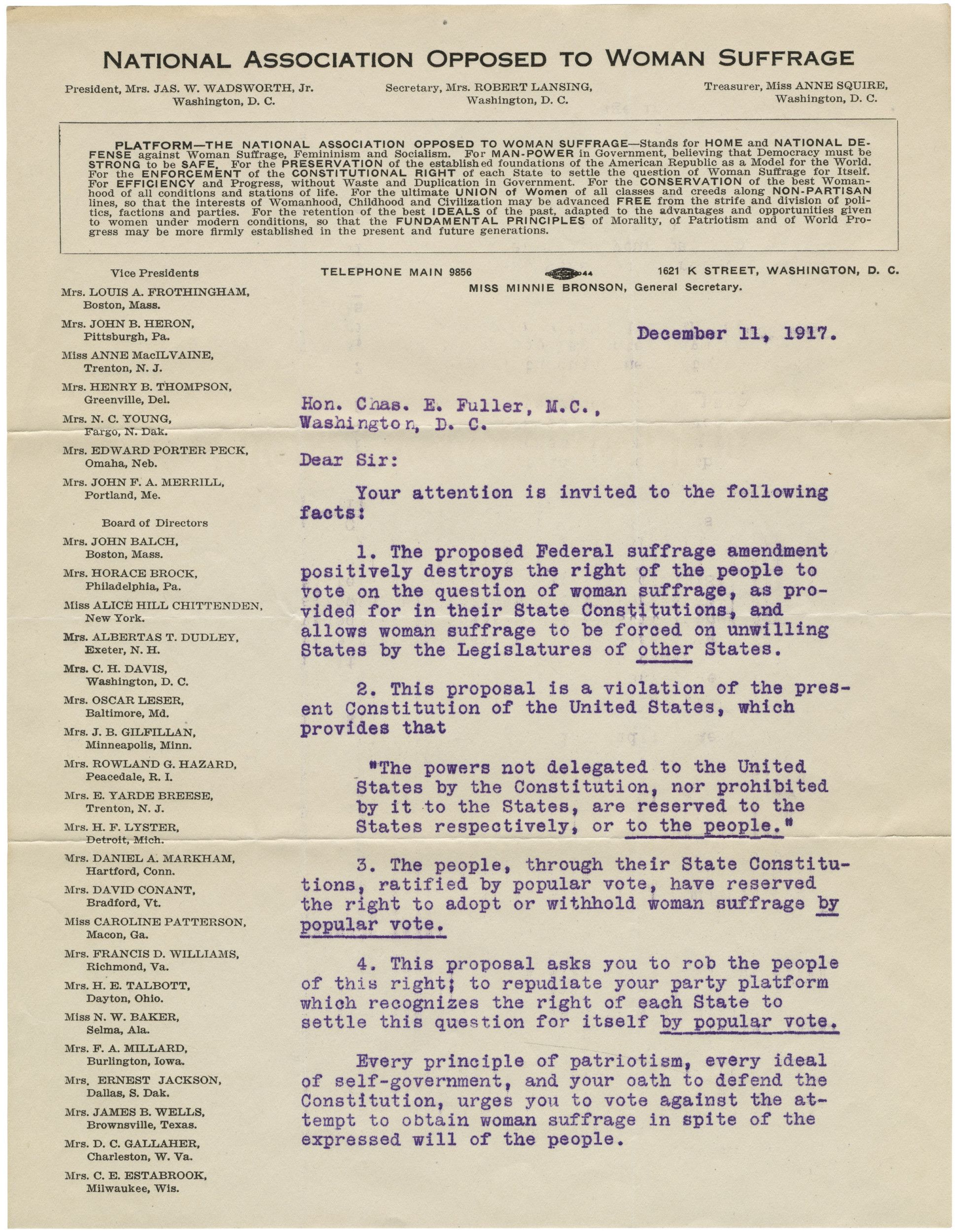
Memorial of Alice Wadsworth of the National Association Opposed to Woman Suffrage
Page 2

Memorial of Alice Wadsworth of the National Association Opposed to Woman Suffrage
Page 3
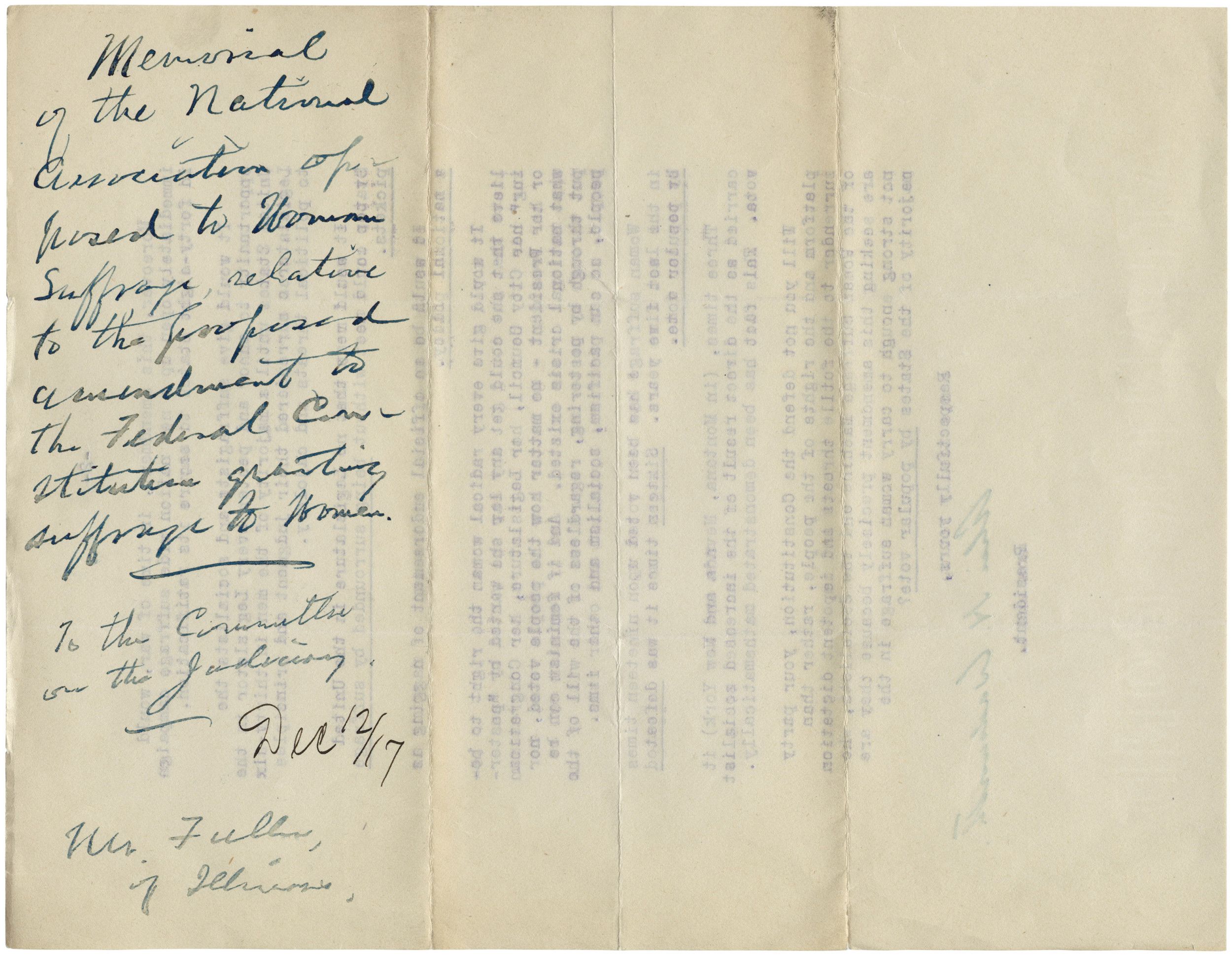
Document
Form letter from E. Cady Stanton, Susan B. Anthony, and Lucy Stone asking friends to send petitions for women's suffrage to their representatives in Congress
12/26/1865
This form letter from Elizabeth Cady Stanton, Susan B. Anthony, and Lucy Stone asks friends to send petitions for women's suffrage to their representatives in Congress.
Transcript
New York, December 26, 1865.Dear Friend:
As the question of Suffrage is now agitating the public mind, it is the hour for Woman to make her demand.
Propositions have already been made on the floor of Congress to so amend the Constitution as to exclude Women from a voice in the Government.* As this would be to turn the wheels of legislation backward, let the Women of the Nation now unitedly protest against such a desecration of the Constitution, and petition for that right which is at the foundation of all Government, the right of representation.
Send your petition, when signed, to your representatives in Congress, at your earliest convenience.
Address all communications to
Standard Office, 48 Beekman St., New York.
In behalf of the National W. R. Com.
E. Cady Stanton,
S.B. Anthony,
Lucy Stone.
*See Bill of Mr. Jenckes, of Rhode Island.
This primary source comes from the Records of the U.S. House of Representatives.
National Archives Identifier: 306686
Full Citation: Form letter from E. Cady Stanton, Susan B. Anthony, and Lucy Stone asking friends to send petitions for women's suffrage to their representatives in Congress; 12/26/1865; (HR 39A-H14.9); Petitions and Memorials Referred to the Committee on the Judiciary, 6/3/1813 - 1998; Records of the U.S. House of Representatives, ; National Archives Building, Washington, DC. [Online Version, https://docsteach.org/documents/document/form-letter-stanton-anthony-stone, April 23, 2024]Form letter from E. Cady Stanton, Susan B. Anthony, and Lucy Stone asking friends to send petitions for women's suffrage to their representatives in Congress
Page 1

Document
Joint Resolution Proposing the Fifteenth Amendment to the United States Constitution
2/26/1869
Passed by Congress on February 26, 1869, and ratified February 3, 1870, the 15th amendment granted African-American men the right to vote: the right of male U.S. citizens to vote shall not be denied or abridged “on account of race, color, or previous condition of servitude.” This document is the joint resolution – a formal opinion adopted by both houses of the legislative branch – proposing the amendment. A constitutional amendment must be passed as a joint resolution before it is sent to the states for ratification.
To former abolitionists and to the Radical Republicans in Congress who fashioned Reconstruction after the Civil War, the 15th amendment appeared to signify the fulfillment of all promises to African Americans. Set free by the 13th amendment, with citizenship guaranteed by the 14th amendment, Black males were given the vote by the 15th amendment.
African Americans voted and held office in many Southern states through the 1880s, but in the early 1890s, steps were taken to ensure subsequent “white supremacy.” The 15th Amendment had been carefully worded to maximize its chances of ratification. It didn't go so far as to grant the right to vote to all citizens regardless of race —instead, it barred states from denying suffrage based on race, opening a loophole for literacy, land ownership, or other requirements. It was a loophole that Southern states quickly exploited to effectively ban Black people from the polls.
Literacy tests for the vote, “grandfather clauses” excluding those whose ancestors had not voted in the 1860s, and other devices to disenfranchise African Americans were written into the laws of former Confederate states.
Social and economic segregation were added to Black America’s loss of political power. In 1896, the Supreme Court decision Plessy v. Ferguson legalized “separate but equal” facilities for the races. For more than 50 years, the overwhelming majority of African American citizens were reduced to second-class citizenship under the “Jim Crow” segregation system.
During that time, African Americans sought to secure their rights and improve their position through organizations such as the National Association for the Advancement of Colored People (N.A.A.C.P.) and the National Urban League, and through the individual efforts of reformers like Booker T. Washington, W.E.B. DuBois, and A. Philip Randolph.
The most direct attack on the problem of African-American disfranchisement came in 1965. Prompted by reports of continuing discriminatory voting practices in many Southern states, President Lyndon B. Johnson urged Congress to pass legislation “which will make it impossible to thwart the 15th amendment.” He reminded Congress that “we cannot have government for all the people until we first make certain it is government of and by all the people.”
The Voting Rights Act of 1965, extended in 1970, 1975, and 1982, abolished all remaining deterrents to exercising the right to vote and authorized federal supervision of voter registration where necessary. In 2013, the Supreme Court struck down a key provision of the act involving federal oversight of voting rules in nine states.
To former abolitionists and to the Radical Republicans in Congress who fashioned Reconstruction after the Civil War, the 15th amendment appeared to signify the fulfillment of all promises to African Americans. Set free by the 13th amendment, with citizenship guaranteed by the 14th amendment, Black males were given the vote by the 15th amendment.
African Americans voted and held office in many Southern states through the 1880s, but in the early 1890s, steps were taken to ensure subsequent “white supremacy.” The 15th Amendment had been carefully worded to maximize its chances of ratification. It didn't go so far as to grant the right to vote to all citizens regardless of race —instead, it barred states from denying suffrage based on race, opening a loophole for literacy, land ownership, or other requirements. It was a loophole that Southern states quickly exploited to effectively ban Black people from the polls.
Literacy tests for the vote, “grandfather clauses” excluding those whose ancestors had not voted in the 1860s, and other devices to disenfranchise African Americans were written into the laws of former Confederate states.
Social and economic segregation were added to Black America’s loss of political power. In 1896, the Supreme Court decision Plessy v. Ferguson legalized “separate but equal” facilities for the races. For more than 50 years, the overwhelming majority of African American citizens were reduced to second-class citizenship under the “Jim Crow” segregation system.
During that time, African Americans sought to secure their rights and improve their position through organizations such as the National Association for the Advancement of Colored People (N.A.A.C.P.) and the National Urban League, and through the individual efforts of reformers like Booker T. Washington, W.E.B. DuBois, and A. Philip Randolph.
The most direct attack on the problem of African-American disfranchisement came in 1965. Prompted by reports of continuing discriminatory voting practices in many Southern states, President Lyndon B. Johnson urged Congress to pass legislation “which will make it impossible to thwart the 15th amendment.” He reminded Congress that “we cannot have government for all the people until we first make certain it is government of and by all the people.”
The Voting Rights Act of 1965, extended in 1970, 1975, and 1982, abolished all remaining deterrents to exercising the right to vote and authorized federal supervision of voter registration where necessary. In 2013, the Supreme Court struck down a key provision of the act involving federal oversight of voting rules in nine states.
Transcript
Fortieth Congress of the United States of America;At the third Session, Begun and held at the city of Washington, on Monday, the seventh day of December, one thousand eight hundred and sixty-eight.
A Resolution
Proposing an amendment to the Constitution of the United States.
Resolved by the Senate and House of Respresentatives of the United States of America in Congress assembled, (two-thirds of both Houses concurring) that the following article be proposed to the legislature of the several States as an amendment to the Constitution of the United States which, when ratified by three-fourths of said legislatures shall be valid as part of the Constitution, namely:
Article XV.
Section 1. The right of citizens of the United States to vote shall not be denied or abridged by the United States or by any State on account of race, color, or previous condition of servitude—
Section 2. The Congress shall have the power to enforce this article by appropriate legislation.
Schuyler Colfax
Speaker of the House of Representatives.
B.F. Wade
President of the Senate pro tempore.
Attent.ED McPherson
Clerk of House of Representatives.
Geo. C. Gorham
Secy of Senate U.S.
This primary source comes from the General Records of the United States Government.
National Archives Identifier: 299797
Full Citation: Joint Resolution Proposing the Fifteenth Amendment to the United States Constitution; 2/26/1869; Enrolled Acts and Resolutions of Congress, 1789 - 2011; General Records of the United States Government, ; National Archives Building, Washington, DC. [Online Version, https://docsteach.org/documents/document/fifteenth-amendment, April 23, 2024]Joint Resolution Proposing the Fifteenth Amendment to the United States Constitution
Page 1
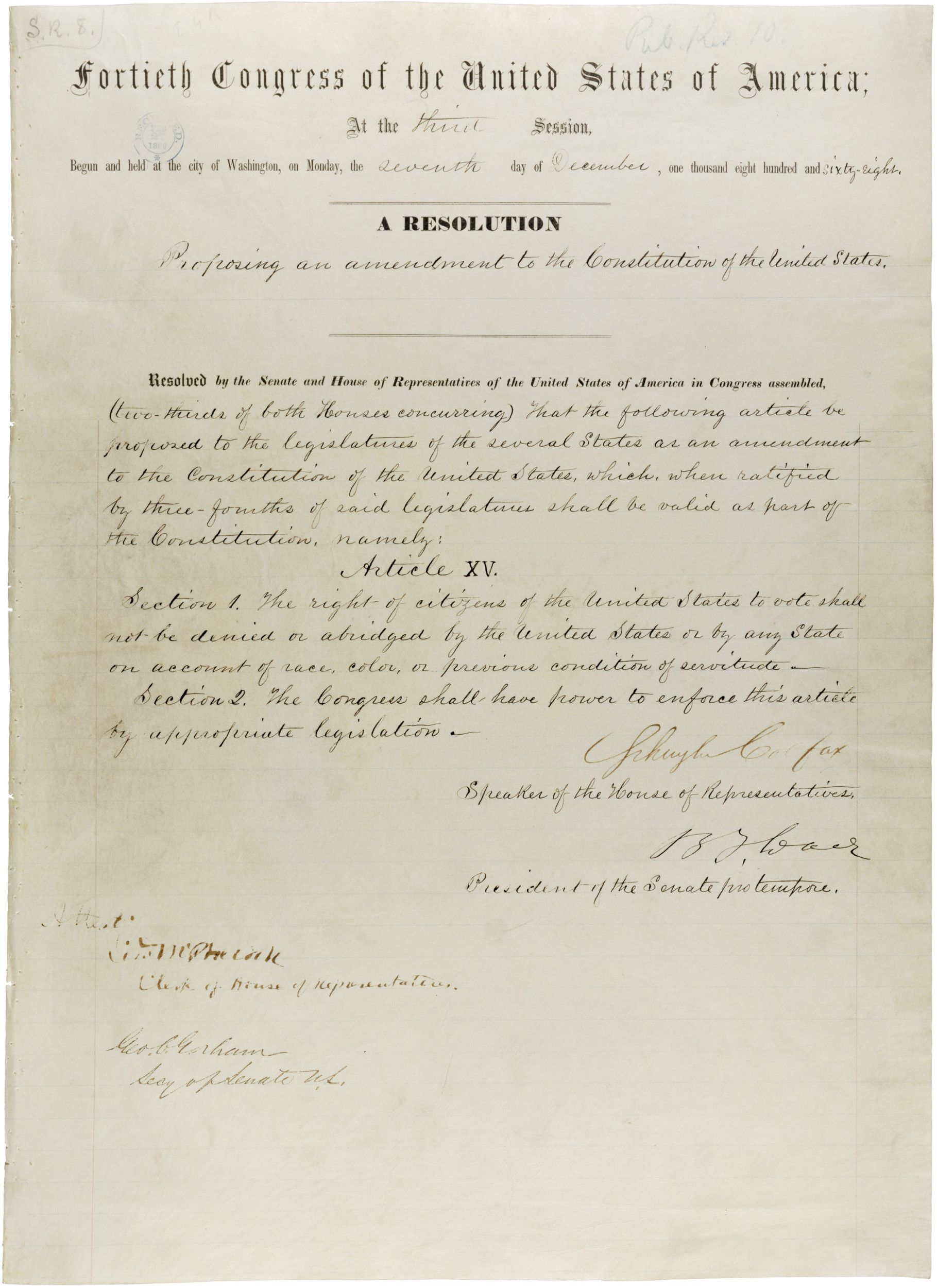
Document
Photograph of Suffrage Parade
1913
In 1906, Elizabeth Cady Stanton’s daughter, Harriot Stanton Blatch, created the Equality League for Self-Supporting Women for professional and industrial working women, later called the Women’s Political Union. Taking the lead from labor unions, the Women’s Political Union organized the first suffrage parade in New York City in 1910.
This photograph of the fourth annual suffrage parade in New York City in 1913 shows some of the march’s 10,000 participants. In the early 20th century, suffragists marched, petitioned, lobbied, and were even arrested in their pursuit of voting rights for women. In 1920, the 19th Amendment to the U.S. Constitution granted women the right to vote.
This photograph of the fourth annual suffrage parade in New York City in 1913 shows some of the march’s 10,000 participants. In the early 20th century, suffragists marched, petitioned, lobbied, and were even arrested in their pursuit of voting rights for women. In 1920, the 19th Amendment to the U.S. Constitution granted women the right to vote.
This primary source comes from the Records of the Office of War Information.
National Archives Identifier: 593561
Full Citation: Photograph 208-PR-14M-3; Photograph of Suffrage Parade; 1913; Photographs Used in Publications, 1943 - 1945; Records of the Office of War Information, ; National Archives at College Park, College Park, MD. [Online Version, https://docsteach.org/documents/document/suffrage-parade, April 23, 2024]Photograph of Suffrage Parade
Page 2
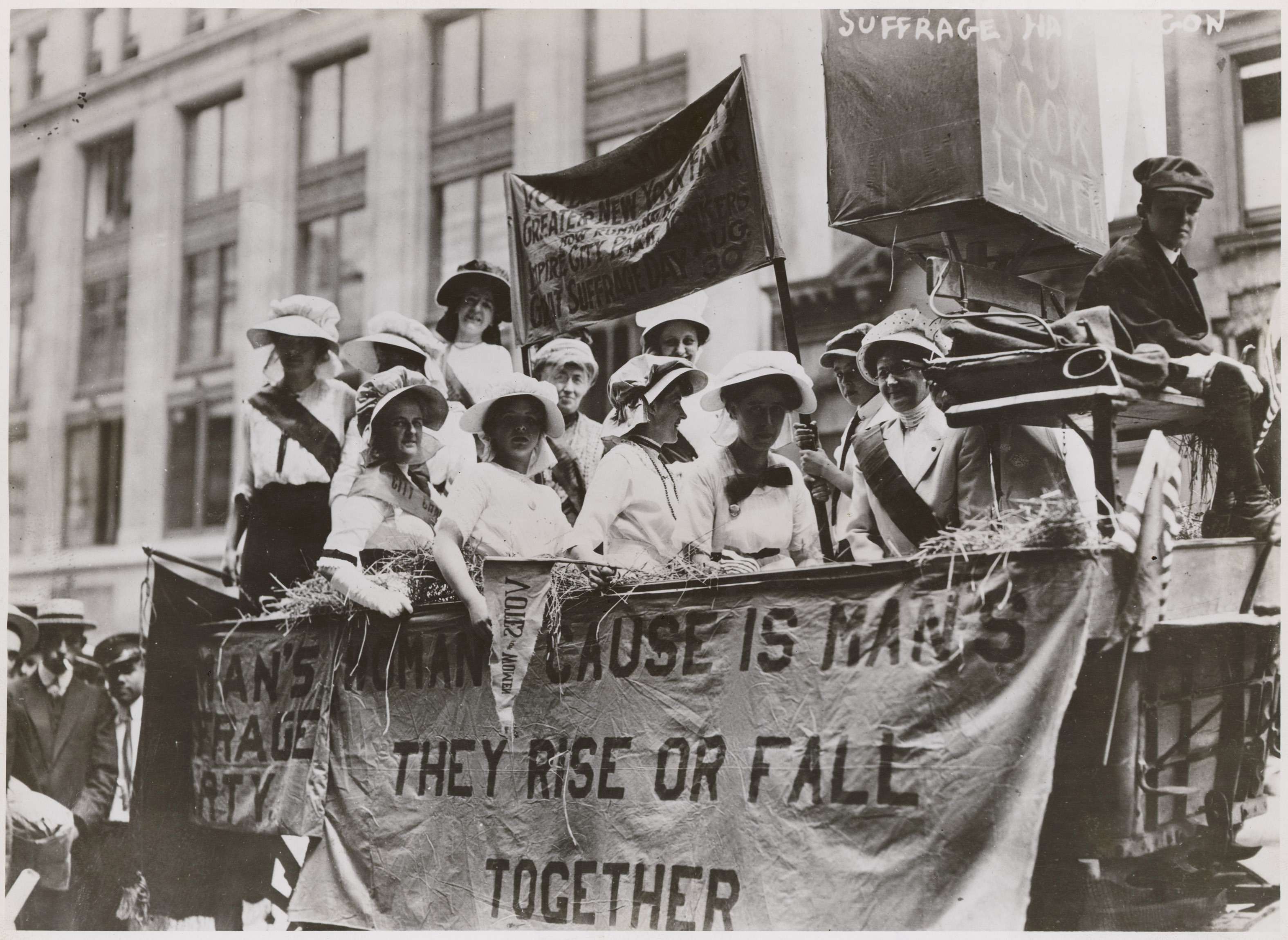
Document
U.S. vs. Susan B. Anthony, Record of Conviction
6/28/1873
Suffragist Susan B. Anthony registered and voted in the election of 1872 in Rochester, New York. As planned, she was arrested for “knowingly, wrongfully and unlawfully vot[ing] for a representative to the Congress of the United States,” convicted by the State of New York, and fined $100.
This is one of several federal court cases involving women arrested for illegally voting in the 1872 election in Rochester, NY, 48 years before the 19th amendment passed in 1920.
This is one of several federal court cases involving women arrested for illegally voting in the 1872 election in Rochester, NY, 48 years before the 19th amendment passed in 1920.
Transcript
And thereupon Richard Crowley Esq., the Attorney of the United States forthe said District, prayed the process of the said District Court for the arrest of the said
Susan B. Anthony and it was granted; and on the 24th day of January in the year of our Lord one thousand eight hundred and seventy-three of the January term of said Court at the City of
Albany ------------------------------------------------ came the Marshal of the United
States for the Northern District of New York, and brought into the said District Court the body
of the said Susan B. Anthony upon the said process; and the said Susan B. Anthony
being duly arraigned upon the said Indictment [Court?] called upon to plead thereto, pleaded that she was not guilty of the offenses charged therein, in manner and form as the same are therein set forth, and of this she put himself [herself above himself] upon the country, and said United States of America did the like.
And ^at the May term of said District Court held at the City of Rochester on the 22 day of May, thereupon the said Richard [Crawley?] the Attorney of the United States, for the Northern District of New York, moved that the said Indictment and the issue joined thereon be transmitted to the Circuit Court of the United States for the said Northern District of New York for disposal therein, and the said motion was granted.
Wherefore let a jury be summoned, empanelled and sworn to try the said issue at the June
Term of said Court in the year of our Lord one thousand eight hundred and seventy-three at theVillage of Canandaigua in the said District.
And now on this [the above this] 17th & 18th days of June of the term of June
one thousand eight hundred and seventy-three aforesaid come as well the Attorney of the United States for the said District as the said Susan B. Anthony and come also the jurors aforesaid;and the said jurors to speak the truth of the matters within contained being chosen, tried and sworn upon their oaths say, that the said Susan B. Anthony is guilty of the offenses charged in the said Indictment in manner and form as the same are therein set forth. And ^[above there on the 19th] there Court, and having heard the said verdict is inquired of by the Court if she has anything to say why the judgment of the law should not be pronounced upon him ^her according to the said verdict: and no sufficient answer being given, His Honor the Judge of the said Court, in the presence of the said Susan B. Anthony does here adjudge and sentence that the said Susan B. Anthony for the said offenses of which she stands convicted as aforesaid be imprisoned in the at hard labor for the term of years and months and pay a fine of one hundred dollars and the arts
of this prosecution.
Charles Mason
Clerk.
131
Circuit Court of the United States.
Circuit Court of the United States
Northern District of New York
[Arch Box ?] 918
THE UNITED STATES
vs.
Susan B. Anthony
RECORD OF CONVICTION
June TERM, 1873
Filed June 28 1873
This primary source comes from the Records of District Courts of the United States.
National Archives Identifier: 278304
Full Citation: U.S. vs. Susan B. Anthony, Record of Conviction; 6/28/1873; Susan B. Anthony Criminal Case File; Criminal Cases Files, 1870 - 1988; Records of District Courts of the United States, ; National Archives at New York, New York, NY. [Online Version, https://docsteach.org/documents/document/susan-b-anthony-conviction, April 23, 2024]U.S. vs. Susan B. Anthony, Record of Conviction
Page 1
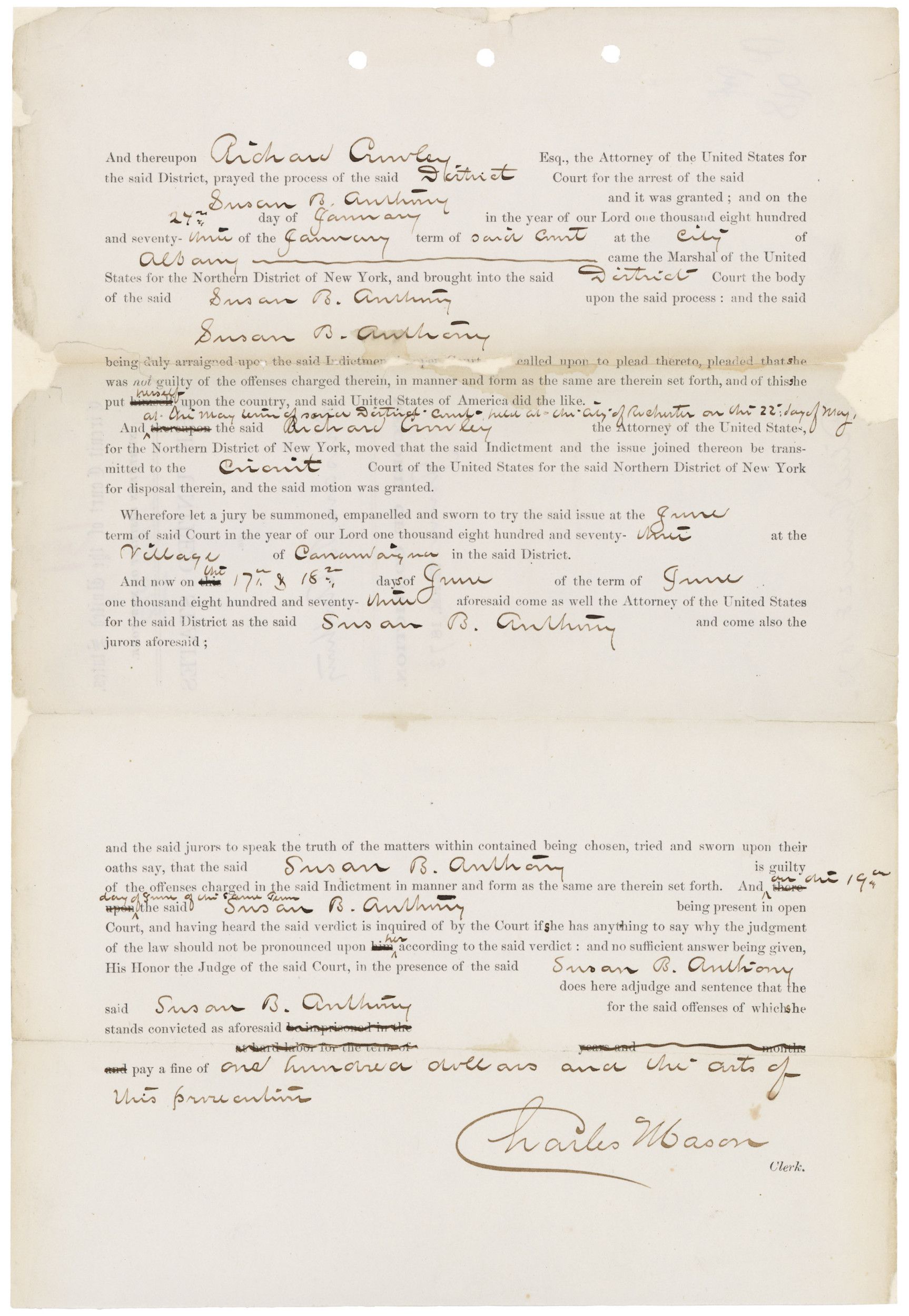
U.S. vs. Susan B. Anthony, Record of Conviction
Page 2

Document
Petition from Minnie Fisher Cunningham of the Texas Woman Suffrage Association for passage of the 'Susan B. Anthony Amendment'
5/2/1916
Minnie Fisher Cunningham, president of the Texas Woman Suffrage Association, sent this petition in support of passage of the Susan B. Anthony Amendment, the name given to the 19th Amendment. In it she stated that "taxation without representation is tyranny!"
Cunningham also wrote "this is not a question in which the State’s Rights bogy is involved." She argued that woman suffrage would not threaten Southern states' rights because suffragists sought no other changes to voting qualifications besides the "removal of sex discrimination." In other words, Southern states' laws designed to prevent people of color from voting would not be threatened.
Cunningham also wrote "this is not a question in which the State’s Rights bogy is involved." She argued that woman suffrage would not threaten Southern states' rights because suffragists sought no other changes to voting qualifications besides the "removal of sex discrimination." In other words, Southern states' laws designed to prevent people of color from voting would not be threatened.
This primary source comes from the Records of the U.S. House of Representatives.
National Archives Identifier: 306659
Full Citation: Petition from Minnie Fisher Cunningham of the Texas Woman Suffrage Association for passage of the 'Susan B. Anthony Amendment'; 5/2/1916; (HR64A-H13.6); Petitions and Memorials, 1813 - 1968; Records of the U.S. House of Representatives, ; National Archives Building, Washington, DC. [Online Version, https://docsteach.org/documents/document/tx-woman-suffrage-petition, April 23, 2024]Petition from Minnie Fisher Cunningham of the Texas Woman Suffrage Association for passage of the 'Susan B. Anthony Amendment'
Page 2
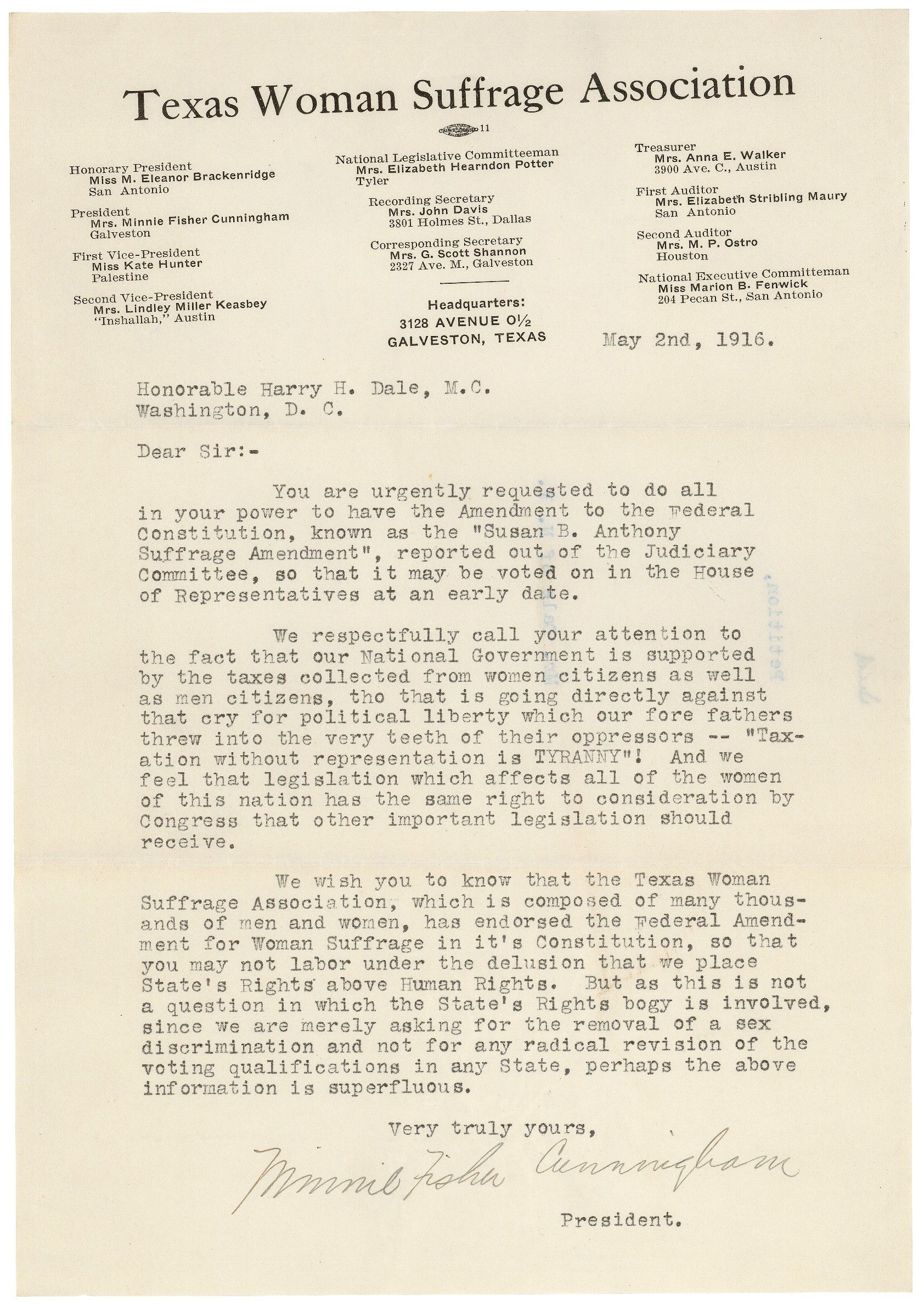
Document
Letter to the United States Congress from Elizabeth Cady Stanton and Susan B. Anthony and Others in Support of Women's Suffrage
12/1871
Elizabeth Cady Stanton, Susan B. Anthony, and four other prominent women's rights leaders addressed this petition to the Senate and House of Representatives. They asked Congress to enact a law giving women in the United States the right to vote. These women also asked to speak before both houses of Congress about this issue.
Stanton and Anthony had formed the National Woman Suffrage Association (NWSA) in May of 1869 – they opposed the 15th amendment (that granted black men the right to vote) because it excluded women. In the year following the ratification of the amendment, the NWSA sent this voting rights petition to Congress.
Vehement disagreement over supporting the 15th Amendment had resulted in a "schism" that split the women's suffrage movement into two new suffrage organizations focusing on different strategies to win women voting rights. One was the NWSA.
The other was the American Woman Suffrage Association (AWSA), founded in 1869 by Lucy Stone, Julia Ward Howe, and Thomas Wentworth Higginson. The AWSA supported the 15th Amendment and protested the confrontational tactics of the NWSA.
Stanton and Anthony had formed the National Woman Suffrage Association (NWSA) in May of 1869 – they opposed the 15th amendment (that granted black men the right to vote) because it excluded women. In the year following the ratification of the amendment, the NWSA sent this voting rights petition to Congress.
Vehement disagreement over supporting the 15th Amendment had resulted in a "schism" that split the women's suffrage movement into two new suffrage organizations focusing on different strategies to win women voting rights. One was the NWSA.
The other was the American Woman Suffrage Association (AWSA), founded in 1869 by Lucy Stone, Julia Ward Howe, and Thomas Wentworth Higginson. The AWSA supported the 15th Amendment and protested the confrontational tactics of the NWSA.
This primary source comes from the Records of the U.S. Senate.
National Archives Identifier: 1634184
Full Citation: Letter to the United States Congress from Elizabeth Cady Stanton and Susan B. Anthony and Others in Support of Women's Suffrage; 12/1871; Petition and Memorials, Resolutions of State Legislatures, and Related Documents which were Referred to the Committee on the Judiciary during the 42nd Congress; (SEN 42A-H11.4); Committee Papers, 1816 - 2011; Records of the U.S. Senate, ; National Archives Building, Washington, DC. [Online Version, https://docsteach.org/documents/document/congress-stanton-anthony, April 23, 2024]Letter to the United States Congress from Elizabeth Cady Stanton and Susan B. Anthony and Others in Support of Women's Suffrage
Page 1

Letter to the United States Congress from Elizabeth Cady Stanton and Susan B. Anthony and Others in Support of Women's Suffrage
Page 2
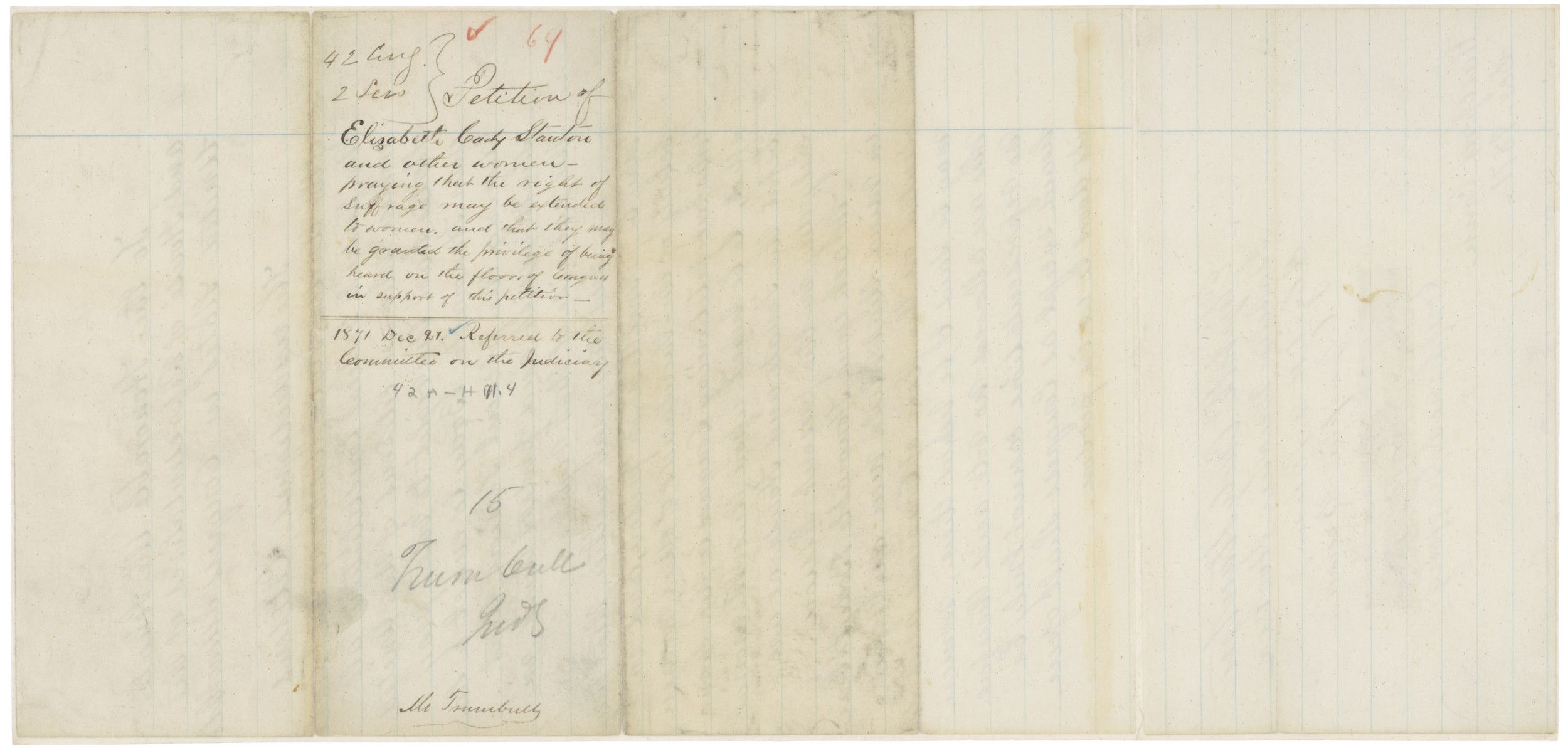
Document
Petition from Carrie Chapman Catt of the National American Woman Suffrage Association asking that a Committee on Woman Suffrage be appointed in the House of Representatives as in the Senate
4/13/1917
Carrie Chapman Catt, who replaced Susan B. Anthony as president of the National American Woman Suffrage Association (NAWSA) in 1900, sent this petition to Champ Clark, speaker of the House of Representatives. In it she asked that a Committee on Woman Suffrage be appointed in the House as in the Senate.
This primary source comes from the Records of the U.S. House of Representatives.
National Archives Identifier: 306662
Full Citation: Petition from Carrie Chapman Catt of the National American Woman Suffrage Association asking that a Committee on Woman Suffrage be appointed in the House of Representatives as in the Senate; 4/13/1917; (HR65A-H8.14); Petitions and Memorials, 1813 - 1968; Records of the U.S. House of Representatives, ; National Archives Building, Washington, DC. [Online Version, https://docsteach.org/documents/document/petition-chapman-catt, April 23, 2024]Petition from Carrie Chapman Catt of the National American Woman Suffrage Association asking that a Committee on Woman Suffrage be appointed in the House of Representatives as in the Senate
Page 1

Petition from Carrie Chapman Catt of the National American Woman Suffrage Association asking that a Committee on Woman Suffrage be appointed in the House of Representatives as in the Senate
Page 2

Document
Anti-Suffrage Postcards from Wallace Ellis to the Honorable Homer P. Snyder
1916
Wallace Ellis sent this postcard opposing the passage of the 19th Amendment to the Constitution to New York Congressman Homer P. Snyder. The amendment would grant women the right to vote on a national basis. Ellis’s opposition was in vain, as Congress passed a resolution proposing the amendment in 1919. After enough states ratified the amendment, Secretary of State Bainbridge Colby certified the ratification, and the 19th Amendment became part of the Constitution on August 26, 1920.
This primary source comes from the Records of the U.S. House of Representatives.
National Archives Identifier: 1633884
Full Citation: Anti-Suffrage Postcards from Wallace Ellis to the Honorable Homer P. Snyder; 1916; Records of the U.S. House of Representatives, . [Online Version, https://docsteach.org/documents/document/antisuffrage-postcard-ellis, April 23, 2024]Anti-Suffrage Postcards from Wallace Ellis to the Honorable Homer P. Snyder
Page 1
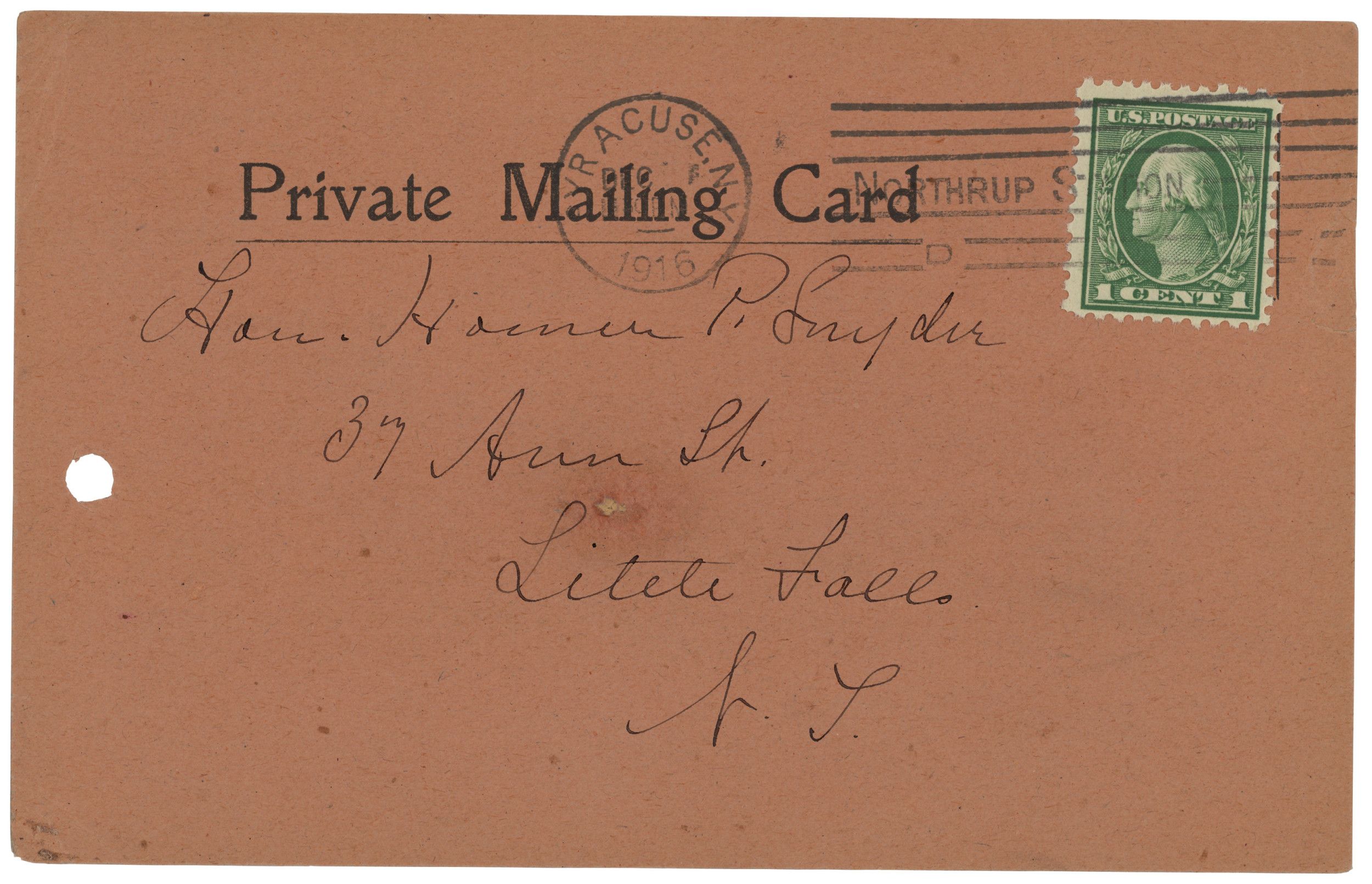
Anti-Suffrage Postcards from Wallace Ellis to the Honorable Homer P. Snyder
Page 2

Document
Tennessee's Ratification of the 19th Amendment
8/24/1920
This is a statement, signed by the Governor of Tennessee in 1920, verifying that the state legislature ratified the 19th Amendment proposed by the U.S. Congress. Tennessee was the 36th out of the existing 48 states to ratify this amendment, clinching the passage of the amendment allowing women the right to vote.
After Congress passed and proposed a women's suffrage amendment, three-fourths of states (36 at that time) had to ratify the 19th Amendment before it could be added to the Constitution. Many states quickly approved the 19th amendment. By the end of March 1920, only one additional state was needed for ratification. On August 18, 1920, after calling a special session of the state legislature, Tennessee became the 36th state to ratify the 19th Amendment.
After Congress passed and proposed a women's suffrage amendment, three-fourths of states (36 at that time) had to ratify the 19th Amendment before it could be added to the Constitution. Many states quickly approved the 19th amendment. By the end of March 1920, only one additional state was needed for ratification. On August 18, 1920, after calling a special session of the state legislature, Tennessee became the 36th state to ratify the 19th Amendment.
This primary source comes from the General Records of the United States Government.
National Archives Identifier: 1501900
Full Citation: Tennessee's Ratification of the 19th Amendment; 8/24/1920; Ratified Amendments, 1795 - 1992; General Records of the United States Government, ; National Archives Building, Washington, DC. [Online Version, https://docsteach.org/documents/document/tn-ratification-19th-amendment, April 23, 2024]Tennessee's Ratification of the 19th Amendment
Page 2
